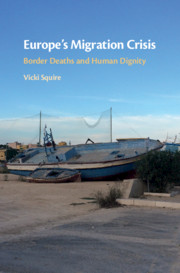Introduction
Europe’s ‘Migration Crisis’: Border Deaths and Human Dignity
Published online by Cambridge University Press: 16 September 2020
Summary
In June 2015, the body of a thirty-four-year-old Syrian woman who had perished at sea was exhumed from her grave in Sicily with the permission of her family, and reburied in Berlin. Part of a political demonstration called ‘The Dead are Coming’, the burial was led by an imam, and was marked by the absence of German politicians, whose names were taped to a row of empty chairs as mourners looked on.2 The reburial was the first in a series organised by a Berlin-based art group called the Centre of Political Beauty, which sought to bring the bodies of those who had drowned in the Mediterranean to ‘the heart of Europe’.3 Describing border deaths as a result of ‘our inaction’ and claiming to give the deceased ‘the dignity that they deserve’, the group stress that it is ‘not just about saving their dignity’ but also that of European populations.4 The Centre of Political Beauty advocates a form of ‘aggressive humanism’ that must ‘hurt provoke and rise in revolt’.5 Just as Antigone refused to be swayed by authorities in marking the death of her ‘dearest brother’ during 442 BC, activists as part of the group seek to ‘do wrong in order to do right’. In a situation whereby border deaths across the Mediterranean are perceived to be met with widespread indifference, the group advances a humanist intervention that ‘assaults’ a form of ‘political apathy’ which is deemed to be deadly. As such, ‘The Dead are Coming’ can be understood as nothing less than an insistent attempt to reaffirm dignity in a situation where it has become lost to both the dead and the living.
- Type
- Chapter
- Information
- Europe's Migration CrisisBorder Deaths and Human Dignity, pp. 1 - 12Publisher: Cambridge University PressPrint publication year: 2020

